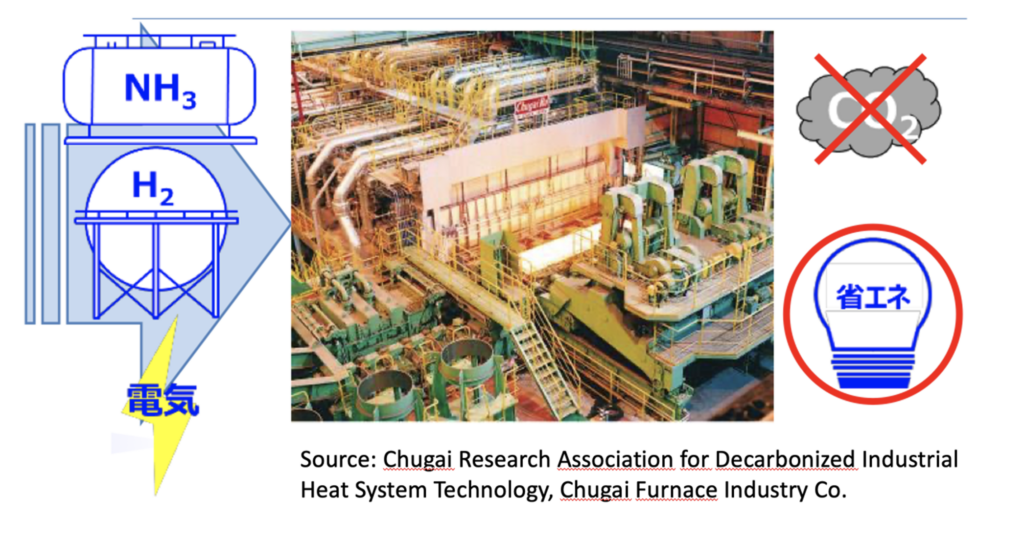https://www.nedo.go.jp/news/press/AA5_101678.
As part of the Green Innovation Fund Project, NEDO will launch the “Decarbonization of Thermal Processes in the Manufacturing Sector” project (total budget: 30.41 billion yen) with the aim of achieving “carbon neutrality by 2050. The project will work on the establishment of combustion technologies required for carbon-neutral industrial furnaces, and technologies for reducing the power receiving capacity and increasing the efficiency of electric furnaces, which are essential for promoting the conversion from combustion furnaces to electric furnaces, as well as on themes for social implementation of these technologies.
Specifically, we will conduct research, development, and demonstration of
- development of common basic technologies for carbon neutral industrial furnaces
- establishment of technologies for ammonia combustion industrial furnaces for handling metal products
- establishment of technologies for hydrogen combustion industrial furnaces for handling metal products, and
- establishment of technologies for reducing the capacity and efficiency of electric furnace power receiving facilities
NEDO will conduct research, development, and demonstration of “establishment of technology for hydrogen combustion industrial furnaces for handling metal products” and “establishment of technology for reducing the capacity and efficiency of electric furnace receiving facilities. Through this project, NEDO aims to contribute to the realization of a decarbonized society and to strengthen the international competitiveness of the Japanese manufacturing industry by developing and implementing carbon neutral industrial furnaces in society.
R&D Item 1] Development of common basic technology for carbon-neutral industrial furnaces
By FY2026, the project aims to establish the common basic technologies necessary to achieve the R&D goals listed in R&D items 2 through 4 below, and to use the results by the time each R&D goal is achieved (FY2031). Specifically, we will develop the basic technology necessary to achieve the same or better level of quality of metal products, NOx emissions, combustion stability and control accuracy, and long-term operational stability by ammonia and hydrogen combustion as existing industrial furnaces. In addition, we will develop the basic technologies necessary to establish general-purpose simulation technology, digital twin technology, and hybrid operation technology that combines ammonia/hydrogen combustion technology and electric heating, in order to predict the impact of applying this technology to existing industrial furnaces, optimize the design, and improve operational efficiency. We will develop the basic technologies necessary to establish hybrid operation technologies that combine ammonia and hydrogen combustion technologies with electric heating.
R&D Item 2] Establish technology for ammonia combustion industrial furnaces that handle metal products.
[1] Establish a 50% co-firing industrial furnace with ammonia and existing fuels such as natural gas (by FY2031).
We will develop a 50% ammonia-fired industrial furnace that meets or exceeds the same standards as existing industrial furnaces in terms of quality of metal products, NOx emissions, combustion stability and control accuracy, and long-term operational stability. Furthermore, we will establish general-purpose simulation technology and digital twin technology to predict the impact of applying this technology to existing industrial furnaces, to optimize the design, and to improve operational efficiency.
[2] Conduct a demonstration test of ammonia firing technology (until FY2031).
We will develop a technology for 100% ammonia fuel mono-firing that achieves the same or better quality of metal products, NOx emissions, combustion stability and control accuracy, and long-term operational stability as existing industrial furnaces. In addition, we will conduct demonstration tests using a system model or a prototype that is assumed to be a fraction of the scale of the actual equipment.
R&D Item 3] Establishment of hydrogen combustion industrial furnace technology for handling metal products.
[1] Establish a 50% co-firing industrial furnace with hydrogen and existing fuels such as natural gas (by FY2031).
We will develop a 50% hydrogen-fired industrial furnace that meets or exceeds the same standards as existing industrial furnaces in terms of metal product quality, NOx emissions, combustion stability and control accuracy, and long-term operational stability. Furthermore, we will establish general-purpose simulation technology and digital twin technology to predict the impact of applying this technology to existing industrial furnaces, to optimize the design, and to improve operational efficiency.
[2] Conduct a demonstration test of hydrogen dedicated combustion technology (until FY2031).
We will develop a 100% hydrogen dedicated combustion technology that achieves metal product quality, NOx emissions, combustion stability and control accuracy, and long-term operational stability at or above the same level as existing industrial furnaces. In addition, we will conduct demonstration tests using a system model or a prototype that is assumed to be a fraction of the scale of the actual furnace.
R&D Item 4] Establishment of technologies to reduce the capacity of electric furnace power receiving facilities and increase efficiency.

